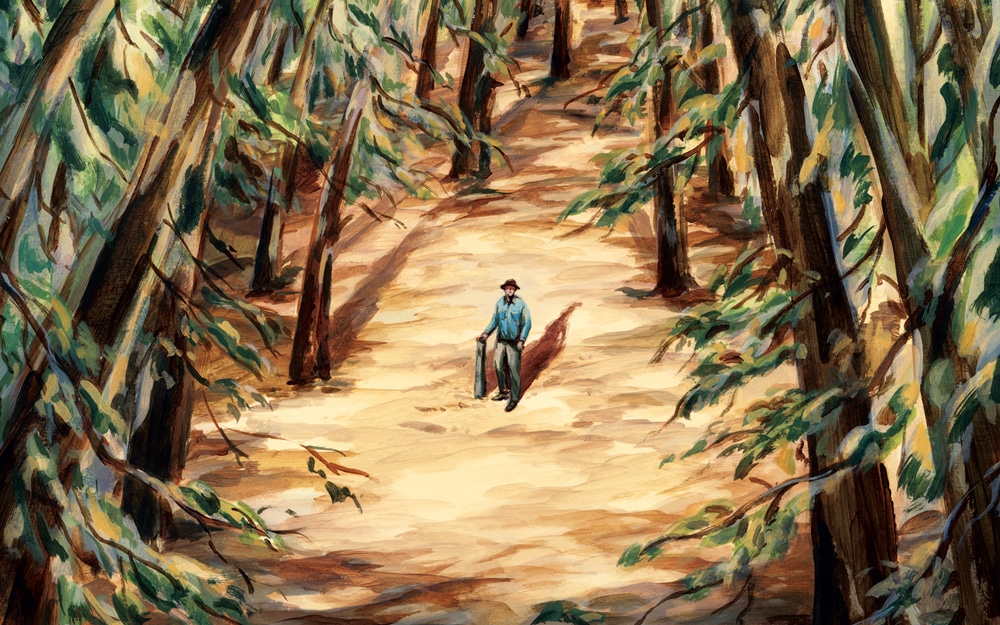The Sanctuary | First Person
By Tim Loftus I stand silently in this hemlock grove a few times each year. Collectively, every tree shares the same name: Tsuga canadensis, or Eastern hemlock, for those who only understand them to be just another commodity of lumber or pulp paper. But to me, each and every one of these trees is my […]

Coffee By Design | Portland, Maine
Photo Credit : Katherine Keenan
Photo Credit : Illustration by Sally Deng
I stand silently in this hemlock grove a few times each year. Collectively, every tree shares the same name: Tsuga canadensis, or Eastern hemlock, for those who only understand them to be just another commodity of lumber or pulp paper. But to me, each and every one of these trees is my friend, if such a thing can be said of a tree. They listen. I listen. I breathe in their breath, a mixture of evergreen scent and life-sustaining oxygen. They breathe in my breath, carbon dioxide, my gift to them to help sustain their lives.
This hemlock grove is perhaps 50 feet wide by 100 feet in length, bisected the long way by the Massachusetts Midstate Trail, a 92-mile-long path that starts on the New Hampshire border and ends on the Rhode Island border. A granite marker near the path shows where the towns of Spencer, Paxton, and Leicester meet, but not where the boundaries are. I don’t know which town claims the roots of these hemlocks, nor do the trees. This information is useless to them, as it should be to me.
I discovered this hemlock grove more than 40 years ago during one of my rambles along a tiny footpath before it was incorporated into the creation of the Midstate Trail. The hemlocks were young—only a decade old, if that. They ranged in size from six to a dozen feet tall and grew so close together that it was hard to tell where one tree ended and another started.
These hemlocks made me feel welcomed whenever I meandered through the grove, their soft-needled young branches brushing against my face and hands as if they were caressing their human friend. And except for the whisper of a gentle breeze through their green fronds or the occasional thunder of beating wings from a startled partridge in the branches, sound from the outside world did not exist.
I felt the healing powers of the grove soon after the unexpected passing of one of my best friends and hiking buddies since junior high. These evergreens absorbed my grief that one cool October afternoon more than two decades ago while I wept out my sorrow. And I have felt the grove’s cathartic energy every time I have entered that stand of trees and come out free from my burdens.
Since that time, the hemlock grove has changed. The path has widened, with more hikers passing through. During the winter, snowmobilers widened the path further, leaving many of the broken or dead small trees to return to the earth. Dirt bikes and quads chewed up the path during the snowless months, opening the stand even more. Then there is just life. Not all trees survive to maturity. Disease, woolly adelgid infestation, lightning strikes, competition from spruce and white pine, and sometimes the chain saw took its toll.
The remaining hemlocks, a fraction of what was once there, are approaching 60 feet in height, their upper branches reaching skyward to harvest more sweet sunshine. Their lower branches, once abundant with soft green needles, no longer exist, long died off in the shade of the tree, having served their purpose as natural solar panels. Conservation of resources, as I understand it—no work, no food—letting go of the unproductive fraction of their lives, their version of a burden, for the body to remain healthy. It’s their lesson to me, one that I need repeated over and over again.
While this hemlock grove looks quite different from years past, it is still, for me, a holy place—a place where I often stand quietly, eyes closed, imagining I, too, have roots reaching down to the bedrock to feel that timeless and purifying strength of something bigger than me rising like sap through my own body to bring me peace.








Nice story that ought to resonate with many. Some spots seem almost sacred in our memories. Any chance Mr. Loftus went to DPHS, late 1970s?